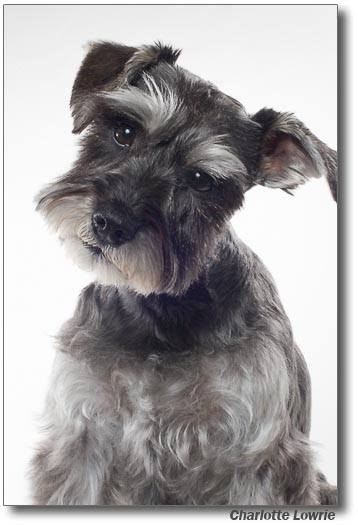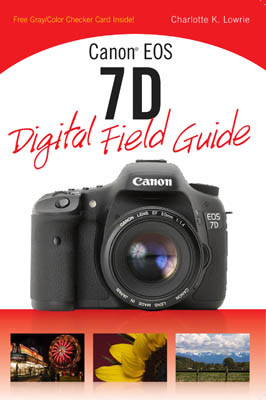By Charlotte Lowrie
One of the best subjects for photography are animals, and especially pets. I've enjoyed photographing my two miniature Schnauzers for the past 11 years, and they remain among my favorite subjects. I had the advantage of being able to acclimate both dogs to the camera and to studio lights from the time they were puppies. Like almost everything else involved in pet ownership, acclimating dogs to being photographed requires patience on your part, repetition, and the promise of rewards for the pets.

If you'd like to have professional looking portraits of your pets, here are some tips I've learned through the years.
- Have everything ready before you bring in the pet. If you are shooting indoors, set up the background, test the lighting, and test the exposure using a stand-in subject before you bring in the pet. I recommend setting a Custom White Balance to keep color-correction to a minimum during image editing. For dogs with a dark coat, set up a silver reflector that will bounce light into the dog's face. I choose the background based on the color of the dog's coat. If you are shooting outdoors, choose a place where the dog is comfortable, but also where he doesn't have a large range of movement. The more you contain the range of movement, the faster the session will progress. Also, choose an outdoor area where there is open shade that does not have dappled light. If you use props such as dog toys, choose them so that their color and size do not distract from the dog who is the subject of the portrait.
For exposure settings, use a fast shutter speed of 1/100 sec. or faster. At slow shutter speeds, any movement of the dog will register as a blur. I always use the lowest ISO that I can to ensure overall excellent image quality. As with people portraits, a wide aperture is a good choice to blur the background while keeping the context of the environment if you're shooting outdoors. In the studio, I often use a narrow aperture that provides excellent detail in the dog's eyes and coat. And in the studio, I use seamless paper backgrounds so that I don't have to worry about blurring background distractions. I also use manual Auto Focus point selection. With Automatic AF point selection, you cannot guarantee that the camera will focus on the dog's nearest eye, and without focus control, the portrait will not be successful. I prefer using a short telephoto lens between 85 and 100mm.
- Establish control. As with any training, the dog should be able to obey commands such as sit, stay, and down. One of the ways that I taught my dogs to cooperate during a photo session was by putting them first on a chair, and then on a table. For dogs that are reluctant to jump down from a height, having them on a table ensures that they will stay where you put them. Other dogs, such as my younger white Schnauzer, will jump off of any table or chair. I had to teach Sadie to stay on the table. It took a few months for her to learn that being on the table meant that we were doing a photo session, but she eventually learned to stay on the table. Also ensure that the table is solid and steady. A wobbly table will frighten the dog, and you won't get either they cooperation or good images.
- Establish rapport. Before the photo session begins, talk to or play with the dog so that a bond is established before you duck behind the camera. The dog's attention should be on you and the affection you share.
- Talk, talk, talk as you shoot. I have always talked to my dogs, and they understand English. If your dogs understand you, then talk to them as you're making pictures. Also, I set the focus set on the dog's eye, and then I move from behind the camera, that is on a tripod, and talk to the dog to get a tilt of the head and to engagement of the dog's eyes. And form my dogs who are both chow hounds, all I have to ask is if they want a treat.
- Try using fun props. I sometimes use human props with the dogs including sunglasses, red bandanas, and hats. While it may sound cheesy, one of my best-selling stock images is of my dog wearing reading glasses at my computer. And don't throw away the imperfect images because they can
 be the most comical of all the images in the session. be the most comical of all the images in the session.
The more you photograph your dogs, the more they become accustomed to the camera. Praise them often for their good behavior in front of the camera, and give them lots of healthy treats. My older Schnauzer has become so acclimated to being photographed in the studio that when a portrait subject arrives, Snickers thinks that she has to be included in the images as well.
You can see more pet portraits in the Snickers and Sadie Gallery.
Also be sure to check out my book, the Canon EOS 7D Digital Field Guide.
Related articles:
|

